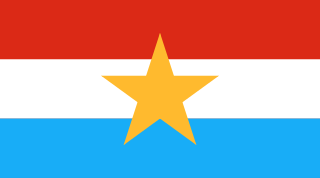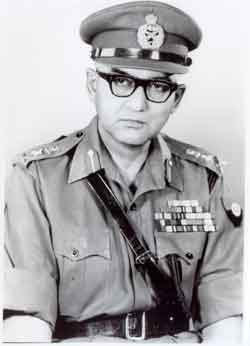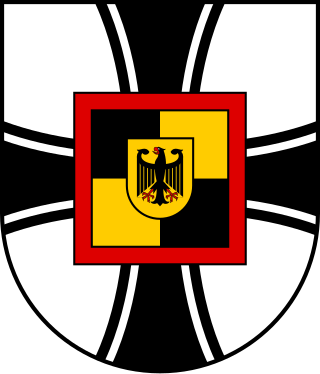
The Bulgarian Army Also called The Bulgarian Armed Forces is the military of Bulgaria. The commander-in-chief is the president of Bulgaria. The Ministry of Defense is responsible for political leadership, while overall military command is in the hands of the Defense Staff, headed by the Chief of the Defense. There are three main branches of the Bulgarian military, named literally the Land Forces, the Air Forces and the Naval Forces.
The Danish Defence is the unified armed forces of the Kingdom of Denmark charged with the defence of Denmark and its self-governing territories Greenland and the Faroe Islands. The military also promote Denmark's wider interests, support international peacekeeping efforts and provide humanitarian aid.

The Tatmadaw or Sit-Tat is the military of Myanmar. It is administered by the Ministry of Defence and composed of the Myanmar Army, the Myanmar Navy and the Myanmar Air Force. Auxiliary services include the Myanmar Police Force, the Border Guard Forces, the Myanmar Coast Guard, and the People's Militia Units. Since independence in 1948, the Tatmadaw has faced significant ethnic insurgencies, especially in Chin, Kachin, Kayin, Kayah, and Shan states. General Ne Win took control of the country in a 1962 coup d'état, attempting to build an autarkic society called the Burmese Way to Socialism. Following the violent repression of nationwide protests in 1988, the military agreed to free elections in 1990, but ignored the resulting victory of the National League for Democracy and imprisoned its leader Aung San Suu Kyi. The 1990s also saw the escalation of the conflict involving Buddhists and Rohingya Muslims in Rakhine State due to RSO attacks on the Tatmadaw forces, which saw the Rohingya minority facing oppression and, starting in 2017, genocide.

The Ministry of Defence is a ministerial department of the Government of the United Kingdom. It is responsible for implementing the defence policy set by the government and serves as the headquarters of the British Armed Forces.

A commander-in-chief or supreme commander is the person who exercises supreme command and control over an armed force or a military branch. As a technical term, it refers to military competencies that reside in a country's executive leadership, a head of state, head of government, or other designated government official.

Defence Intelligence (DI) is an organisation within the United Kingdom intelligence community which focuses on gathering and analysing military intelligence. It differs from the UK's intelligence agencies in that it is an integral part of a government department – the Ministry of Defence (MoD) – rather than a stand-alone organisation. The organisation employs a mixture of civilian and military staff and is funded within the UK's defence budget. The organisation was formerly known as the Defence Intelligence Staff (DIS), but changed its name in 2009.

The Chiefs of Staff Committee (CSC) is composed of the most senior military personnel in the British Armed Forces who advise on operational military matters and the preparation and conduct of military operations. The committee consists of the Chief of the Defence Staff who is the chairman and professional head of the forces, the Vice-Chief of the Defence Staff, who is the vice-chairman and deputy professional head of the armed forces. The committee also consists of the professional heads of each branch of the armed forces: the First Sea Lord and Chief of the Naval Staff, the Chief of the General Staff and the Chief of the Air Staff.

The Singapore Army is the land service branch of the Singapore Armed Forces (SAF). The largest of the four branches of the SAF, the Singapore Army traces its origins to the 1st Battalion, Singapore Infantry Regiment, which was formed in 1957, when Singapore was still under British colonial rule. After Singapore's independence on 9 August 1965, the Singapore Army Bill was passed in Parliament on 23 December 1965, and National Service (NS) was subsequently introduced in 1967. Mostly made up of conscripts, the Singapore Army can mobilise all operationally-ready military reservists in the event of war or national exigencies.

The Federal Ministry of Defence, abbreviated BMVg, is a top-level federal agency, headed by the Federal Minister of Defence as a member of the Cabinet of Germany. The ministry is headquartered at the Hardthöhe district in Bonn and has a second office in the Bendlerblock building in Berlin, which is occasionally used colloquially to denote the entire Ministry.

The United Kingdom's Strategic Command (StratCom), previously known as Joint Forces Command (JFC), manages allocated joint capabilities from the three armed services.

The Ministry of Defence is the Dutch ministry responsible for the armed forces of the Netherlands and veterans' affairs. The ministry was created in 1813 as the Ministry of War and in 1928 was combined with the Ministry of the Navy. After World War II in the ministries were separated again, in this period the Minister of War and Minister of the Navy were often the same person and the state secretary for the Navy was responsible for daily affairs of the Royal Netherlands Navy. In 1959 the ministries were merged once again. The ministry is headed by the Minister of Defence, currently Kajsa Ollongren, assisted by the Chief of the Defence, Onno Eichelsheim since April 2021.

The Ministry of Defence of Ukraine is the ministry of the Ukrainian government that oversees national defence and the Armed Forces of Ukraine. The head of the ministry is the Minister of Defence. The President of Ukraine is the Supreme Commander-in-Chief of the Armed Forces of Ukraine.

General Gopal Gurunath Bewoor PVSM was a senior officer of the Indian Army who served as the 8th Chief of Army Staff, and later an Indian diplomat to Denmark.

The Ministry of Defense was a government ministry in the Soviet Union, which supervised the Soviet Armed Forces. The first Minister of Defense was Nikolai Bulganin, starting 1953.

The Armed Forces General Staff, or EMGFA, is the supreme military body of Portugal. It is responsible for the planning, command and control of the Portuguese Armed Forces.

The Armed Forces Staff, in the meaning of General staff, of the German Bundeswehr was the central department of the Federal Ministry of Defence (MOD) in direct subordination to the Inspector General of the Bundeswehr and one of the five staff headquarters in the military command of the German Bundeswehr.

The Bulgarian People's Army was the army of the People's Republic of Bulgaria. It comprised the Bulgarian Land Forces, Air Force and Air Defence, Navy and supporting arms. Bulgaria was one of the signatories of the Warsaw Pact. Along with troops from other Warsaw Pact countries, the BNA participated in the Warsaw Pact invasion of Czechoslovakia in 1968. However, other than this, the BNA did not see any combat during its existence. The Bulgarian People's Army was dissolved along with the People's Republic of Bulgaria in 1990 and was succeeded by the Bulgarian Armed Forces.

The Integrated Defence Staff (IDS) is an organisation responsible for fostering coordination and enabling prioritisation across the different branches of the Indian Armed Forces. It is composed of representatives from the Indian Army, Indian Navy, Indian Air Force, Ministry of External Affairs, Defence Research and Development Organisation, Ministry of Defence and Ministry of Finance. The IDS is headed by Chief of Integrated Defence Staff along with Deputy Chiefs of Integrated Defence Staff. On December 24, 2019, the Cabinet Committee on Security (CCS) established the post of Chief of Defence Staff, a four-star general, a tri-service Chief, that shall lead the defence forces as well as play the role of head of the Department of Military Affairs. The body advises and assists the Chief of Defence Staff.

The Swedish Armed Forces Headquarters is the highest level of command in the Swedish Armed Forces. Established in 1994, its primary task is to command operations, but is also involved in areas such as military strategy, the overall development of the Swedish Armed Forces, and acting as a channel of contact with government. It's located at Lidingövägen 24 at Gärdet in Stockholm.

Flemming Lentfer is a Danish General, who served as Chief of Defence from 1 December 2020 to 3 April 2024. Prior to Lentfer becoming Chief of Defence, he served as Director for the Danish Defence Acquisition and Logistics Organization and National Armaments Director.




















